|
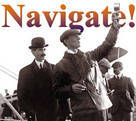
 Up
Up 
 Aerodrome
Aerodrome
Beginnings

(You are here.)



  Need
to Need
to
find your
bearings?
Try
these
navigation aids:
If
this is your first
visit, please stop by:
Something
to share?
Please:



|
|
Available in Française, Español, Português, Deutsch, Россию,
中文,
日本, and others.
 harles
Walcott had been deeply involved with the Aerodrome long before the
Hammondsport trials. He had, in fact, played a vital role in its
inception in 1898. By that time, he had been a player in Washington
for nearly two decades. Walcott had joined the United States
Geological Survey (USGS) as “employee #20” in 1879 and quickly rose
through the ranks. Not only did he write three ground-breaking works
on paleontology in the span of a decade, he was adept at working
with organizations outside the USGS. He organized the Smithsonian’s
growing fossil collection and produced a massive paleontological
exhibit for Chicago’s 1893 Columbian Exhibition. harles
Walcott had been deeply involved with the Aerodrome long before the
Hammondsport trials. He had, in fact, played a vital role in its
inception in 1898. By that time, he had been a player in Washington
for nearly two decades. Walcott had joined the United States
Geological Survey (USGS) as “employee #20” in 1879 and quickly rose
through the ranks. Not only did he write three ground-breaking works
on paleontology in the span of a decade, he was adept at working
with organizations outside the USGS. He organized the Smithsonian’s
growing fossil collection and produced a massive paleontological
exhibit for Chicago’s 1893 Columbian Exhibition.
In 1894, the
Director of the USGS, Major John Wesley Powell, fell afoul of
Congress over policies that restricted the development of western
lands. He was forced to resign and Walcott was appointed to the
directorship, not because he was the most senior or the most
accomplished scientist at the USGS, but because it was generally
agreed that he had the political acumen to repair links with
Congress. That trust was well-founded. By 1898, Walcott had doubled
the size and responsibilities of the USGS, as well as its allotted
funding. He had also cultivated many useful friendships around town
and was on a first-name basis with President William McKinley.
In 1897, George
Brown Goode, the Assistant Secretary of the Smithsonian Institution,
died unexpectedly. The Smith keenly felt his loss. Goode, an
accomplished naturalist, historian and author, was the first
director of the National Museum and was being groomed for the top
position. Secretary
Samuel
P. Langley, who had been in charge since 1887, was a popular
figurehead. Every American was thankful to him for making the
railroads run on time – he had established time zones and then
telegraphed accurate time data (based on astronomical observations)
to the railroad stations. His subsequent discovery of sun spots and
exciting experiments with unmanned flying “aerodromes” had kept him
in the news and made the Smithsonian a household word. But his
micromanagement and autocratic airs limited his effectiveness as a
leader, and his reclusiveness and aversion to publicity diminished
him politically. By contrast, Goode was a respected and energetic
leader, a brilliant planner and organizer, and the Smithsonian’s
best political asset. With Goode gone, the Smith was in trouble.
The Smithsonian
Board of Regents offered the Assistant Secretary position to Walcott
knowing he was one of the few who could fill Goode’s shoes. He
wouldn’t even have to move – the USGS offices were in the
Smithsonian’s overcrowded National Museum building. After much
cajoling, Walcott agreed to take on the position in addition to his
USGS duties only until another suitable candidate could be found.
Once in the saddle, he attacked the problems he saw with
characteristic energy and immediately began reorganizing the museum,
instituting an administrative system that lasts to this day.
The Smithsonian
of 1897 was not the powerhouse that now dominates the Mall in the
center of Washington DC. It had been ignored and underfunded by
Congress since its inception in 1846. The Institution was the result
of a decade-long debate of what to do with James Smithson’s
half-million-dollar bequest to the United States of America for “the
increase & diffusion of knowledge among men.” Its central building,
nicknamed “The Castle,” was built in 1855. The National Museum
Building was built nearby in 1881, mostly to house exhibits left
over from the 1876 Centennial International Exposition of
Philadelphia – the first World’s Fair. By the end of the nineteenth
century, the Smithsonian was crippled by a lack of space. Langley
had added a zoological park – the National Zoo – in 1889, but that
had done nothing to alleviate the overcrowding.
Walcott was
well-aware than the Smithsonian needed to expand, and was equally
mindful that it needed the support of Congress to do so. It must
have occurred to him that a big win for the Smith would go a long
way’s toward polishing its reputation and attracting political
support. In February of 1898, two events combined that allowed him
to produce that win. First, the February edition of Popular
Science published a laudatory biography of Walcott that
ratcheted his reputation up several notches. And second, the
explosion of the U.S.S. Maine in Havana Harbor that same
month caused the U.S. military to inventory its weapons as war with
Spain became imminent. In his diary, Walcott described what happened
next:
-
March 21, 1898 – Walcott runs across
Langley in his workshop, which was proximate to Walcott’s
paleontology lab. They discuss adapting Langley’s aerodrome
design to carry a man. Langley is positive; says such as thing
could be of great service to his country.
-
March 22, 1898 – Walcott meets Langley
again and asks if he was serious about building a manned
aerodrome. Langley says, “Yes, if the money could be secured.”
-
March 24, 1898 – Walcott calls on President
McKinley and tells him about the “Langley flying machine.”
McKinley suggests he talk to Secretary of War George de Rue Meiklejohn and Assistant Secretary of the Navy Theodore
Roosevelt.
-
March 25, 1898 – Walcott meets with
Roosevelt. Roosevelt pens a memorandum to other members of the
War Department saying, “…the machine has worked. It seems to me
worthwhile for this government to try whether or not it will
work on a large enough scale to be of use in the event of war.”
In April,
Roosevelt convened a committee with members from the Army, Navy, and
civilian sector. After discussions with Langley, the committee
recommended pursuing a manned aerodrome and forwarded their
recommendation to the Army and Navy. The Navy declined, saying that an airplane would likely be of
more use on land. But the Army bit and in November it assigned
Langley the task of developing a manned airplane for military use. They agreed to fund the program for $50,000 –
$25,000 in 1898 and another $25,000 in 1899 if sufficient progress
was made. It was also
supposed to be a secret program, but an account of the Langley's
windfall appeared in the newspaper the very next day.
And it was big
news, Just the funding was an earth-shaking accomplishment. The War Department’s
Board of Ordinance, which provided the money, had never before
invested in the actual development of a technology. They were
legendary misers; hoarders that had defied President Abraham Lincoln
and delayed the distribution of repeating rifles to the U.S. Army
during the American Civil War on the grounds that they would “waste
bullets.” In getting them to fund a speculative experiment, Langley
– with Walcott’s initiative – had moved a mountain. And this
achievement had its desired effect. In 1902, while Langley’s star
was still on the rise, Congress agreed to erect a new building for
the National Museum, directly across the Mall from the Smithsonian
Castle.
|
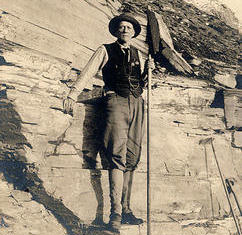
Charles Walcott discovered the Burgess Shale in the Canadian Rockies
and the mother load of fossils it contained from the Cambrian
period, 505 million years ago.
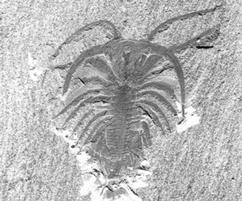
A Marrella Splendens or
"Lace Crab" fossil, excavated by Walcott. Eventually, he would
uncover over 65,000 specimens of Cambrian life from the shale.
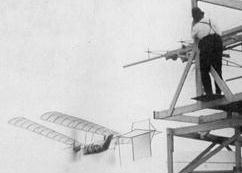
Langley's unmanned Aerodrome No. 5, was successfully launched on 6
May 1896. The Smithsonian would eventually declare 6 May as "Langley
Day."
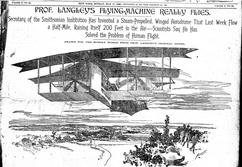
Langley's aerodrome flights made good copy for the media – and good
public relations for the Smithsonian – as this New York World story
indicates.
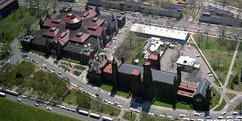
The Smithsonian "Castle" (right) and the Arts and Industries
Building (left). Until 1911, these two buildings comprised most of
the office and exhibit space in the Smithsonian.
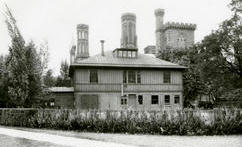
Both Langley's aeronautical workshop and Walcott's paleontological
laboratory were in the South Shed, behind the Castle.
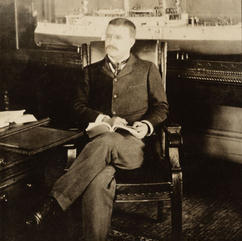
Assistant Secretary to the Navy Theodore Roosevelt in 1897.
|